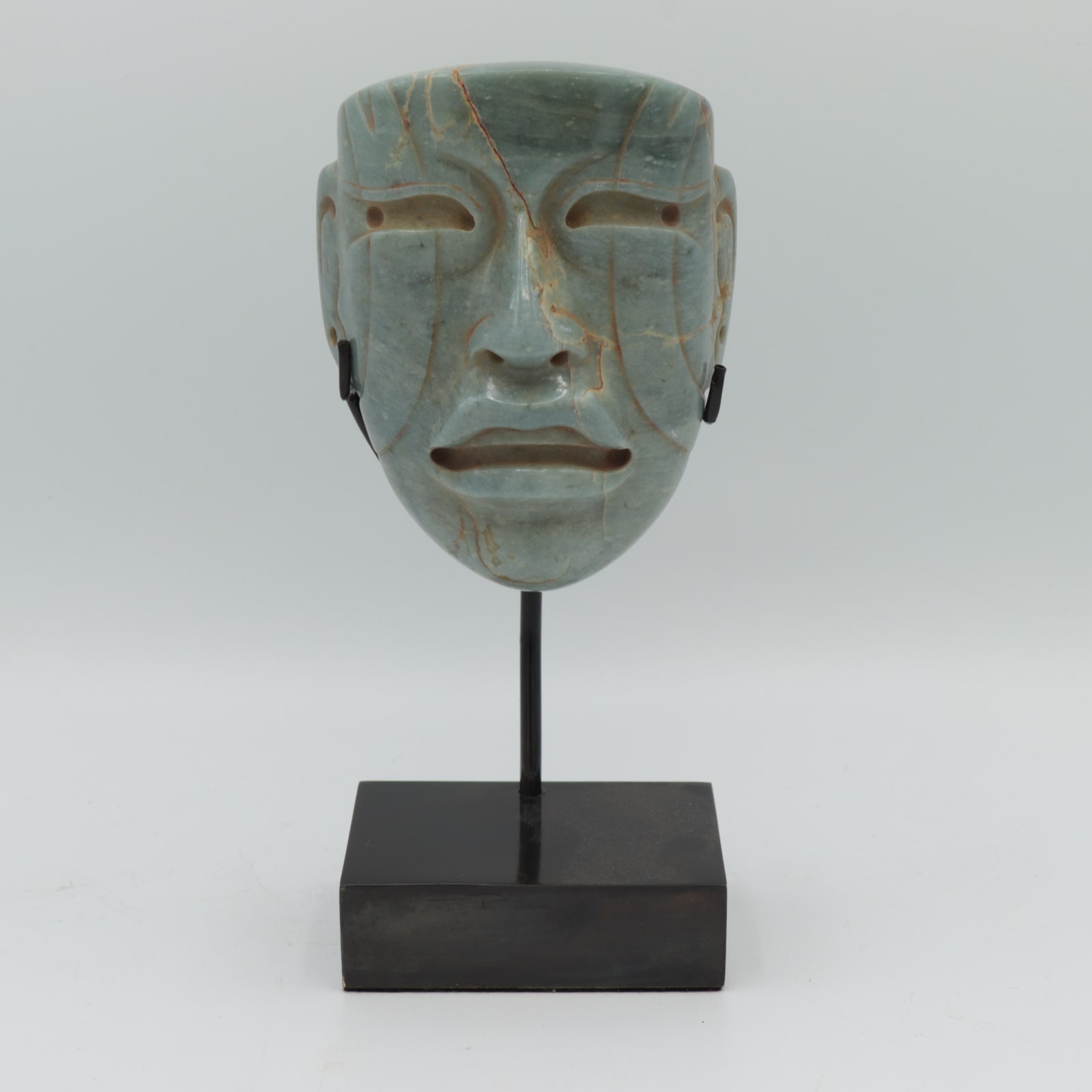Olmec Jade Mask, 1600-400 BCE
Jade
height 10.7 cm
height 4 1/4 in
Dimensions provided without mounting
height 4 1/4 in
Dimensions provided without mounting
EL.0064
The Olmec civilisation was one of the earliest civilisations in Mesoamerica, lasting from around 1600 to 400 BCE, and it was based in the modern-day Mexican states of Veracruz and...
The Olmec civilisation was one of the earliest civilisations in Mesoamerica, lasting from around 1600 to 400 BCE, and it was based in the modern-day Mexican states of Veracruz and Tabasco, on the coast of the Gulf of Mexico. They are thought to have invented several Mesoamerican traditions such as bloodletting and the Mesoamerican ballgame, as well as possibly the Mesoamerican calendar, zero, and popcorn. Their first important centre was in San Lorenzo Tenochtitlán, and after that it appears to have moved to La Venta. The region provided many advantages for a burgeoning civilisation, such as alluvial soil which can be highly fertile, and access to the Coatzacoalcos River basin, which offered opportunities for transportation. The dense population which formed in this area is thought to have led to the rise of an elite, creating demand for luxury items made of high-value materials which came to characterise Olmec culture.
This mask is made of jade, a material that was highly valued for its colour and translucent appearance. The fact that the only source in ancient Mesoamerica was the Motagua River valley, in eastern Guatemala, and therefore it would have been necessary to transport it a considerable distance in order to use it for Olmec objects, would have added to the prestige of artworks made from this material. The face portrayed on this mask has recognisably human features, but it is not naturalistic, instead employing a distinctive stylisation (“Olmec style”) that is thought to merge human features with those of jaguars, which were important in Olmec religion. The “Olmec style” features of this mask are the deep-set eyes and nostrils, and a prominent mouth. The lips are full, and a row of teeth is visible, although the individual teeth are not delineated. The furrowing of the brow over the eyes gives this mask a sorrowful expression. There are also raised stripes across each cheek, crossing the eyes to the forehead.
Representations with similar features have often been associated with a supernatural entity known as a ‘were-jaguar’ which was thought to occupy a prominent place in Olmec belief. The eyes are narrow and widen at the outer corners. There are holes drilled through the temples and below the ears of the mask, which could allow it to be put on a string. There are also drill-marks in the earlobes, at the outer corners of each eye, in each nostril, and at both corners of the mouth, but these do not pierce through the whole depth of the mask. These could have been used as guidelines to mark out where the facial features were going to go, which were left visible for aesthetic reasons. The fact that there are not pierced holes for the eyes, as well as the small size of the mask, suggests that it would not actually have been worn on the face. It may instead have been tied around the owner’s arm, or suspended on their chest. However this object was practically used, it would have functioned symbolically as a status symbol, because of the high quality of the material as well as its beauty.
This mask is made of jade, a material that was highly valued for its colour and translucent appearance. The fact that the only source in ancient Mesoamerica was the Motagua River valley, in eastern Guatemala, and therefore it would have been necessary to transport it a considerable distance in order to use it for Olmec objects, would have added to the prestige of artworks made from this material. The face portrayed on this mask has recognisably human features, but it is not naturalistic, instead employing a distinctive stylisation (“Olmec style”) that is thought to merge human features with those of jaguars, which were important in Olmec religion. The “Olmec style” features of this mask are the deep-set eyes and nostrils, and a prominent mouth. The lips are full, and a row of teeth is visible, although the individual teeth are not delineated. The furrowing of the brow over the eyes gives this mask a sorrowful expression. There are also raised stripes across each cheek, crossing the eyes to the forehead.
Representations with similar features have often been associated with a supernatural entity known as a ‘were-jaguar’ which was thought to occupy a prominent place in Olmec belief. The eyes are narrow and widen at the outer corners. There are holes drilled through the temples and below the ears of the mask, which could allow it to be put on a string. There are also drill-marks in the earlobes, at the outer corners of each eye, in each nostril, and at both corners of the mouth, but these do not pierce through the whole depth of the mask. These could have been used as guidelines to mark out where the facial features were going to go, which were left visible for aesthetic reasons. The fact that there are not pierced holes for the eyes, as well as the small size of the mask, suggests that it would not actually have been worn on the face. It may instead have been tied around the owner’s arm, or suspended on their chest. However this object was practically used, it would have functioned symbolically as a status symbol, because of the high quality of the material as well as its beauty.
